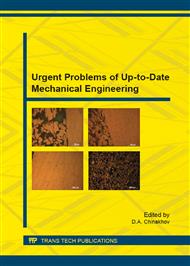[1]
H. Kolsky, An investigation of mechanical properties of materials at very high rates of loading, Proceedings of the Physics Society of London B 62 (1949) 676-700.
DOI: 10.1088/0370-1301/62/11/302
Google Scholar
[2]
A.S. Yunoshev, V. V Sil'vestrov, Development of the polymeric split Hopkinson bar technique, J. Journal of Applied Mechanics and Technical Physics 42(3) (2001) 558-564.
Google Scholar
[3]
A.M. Bragov, A.K. Lomunov, A.A. Medvedev, A modified Kolsky method for the investigation of the strain-rate history dependence of mechanical properties of materials, J. de Physique IV 1 (1991) 471-475.
DOI: 10.1051/jp4:1991367
Google Scholar
[4]
F. Jiang, K.S. Vecchio, Hopkinson bar experimental technique: a critical review on dynamic fracture toughness measurement, J. Applied Mechanics Review 62 (060802) (2009) 1-39.
DOI: 10.1115/1.3124647
Google Scholar
[5]
X.L. Dong, M.Y. Leung, T.X. Yu, Characteristics method for viscoelastic analysis in a Hopkinson tensile bar, J. International Journal of Modern Physics B 22(9, 10, 11) (2008) 1062-1067.
DOI: 10.1142/s0217979208046323
Google Scholar
[6]
A. Bragov, A. Konstantinov, A. Lomunov, A. Sadyrin, I. Sergeichev, L. Kruszka, Dynamic compressibility of high-porosity dampers of thermal and shock loadings. J. Modeling and experiment, International Journal of Modern Physics B 22(9, 10, 11) (2008).
DOI: 10.1142/s0217979208046517
Google Scholar
[7]
Z. -J. Sun, L. -L. Wang, Studies on dynamic damage evolution for PP/PA polymer blends under high strain rates, J. International Journal of Modern Physics B 22(9, 10, 11) (2008) 1409-1416.
DOI: 10.1142/s0217979208046852
Google Scholar
[8]
S.A. Zelepugin, A.S. Zelepugin, Modeling of the destruction of targets during a high-velocity impact, J. Russian Journal of Physical Chemistry B 2(2) (2008) 246-250.
DOI: 10.1134/s1990793108020127
Google Scholar
[9]
G.I. Kanel, V.E. Fortov, S.V. Razorenov, Shock waves in condensed-state physics, J. Physics-Uspekhi 50(8) (2007) 771-791.
DOI: 10.1070/pu2007v050n08abeh006327
Google Scholar
[10]
W.H. Gust, High impact deformation of metal cylinders at elevated temperatures, J. Appl. Phys. 53(5) (1982) 3566-3575.
DOI: 10.1063/1.331136
Google Scholar
[11]
G.R. Johnson, W.H. Cook, A constitutive model and data for metals subjected to large strains, high strain rates and high temperatures, Proc. 7th Int. Symp. on Ballistics, (1983) 541–547.
Google Scholar
[12]
S.R. Beissel, C.A. Gerlach, G.R. Johnson, Hypervelocity impact computations with finite elements and meshfree particles, J. International Journal of Impact Engineering 33 (2006) 80-90.
DOI: 10.1016/j.ijimpeng.2006.09.047
Google Scholar
[13]
V.A. Gorelski, S.A. Zelepugin, A. Yu. Smolin, Effect of discretization in calculating three-dimensional problems of high-velocity impact by the finite-element method, J. Computational Mathematics and Mathematical Physics 37(6) (1997) 722-730.
Google Scholar


